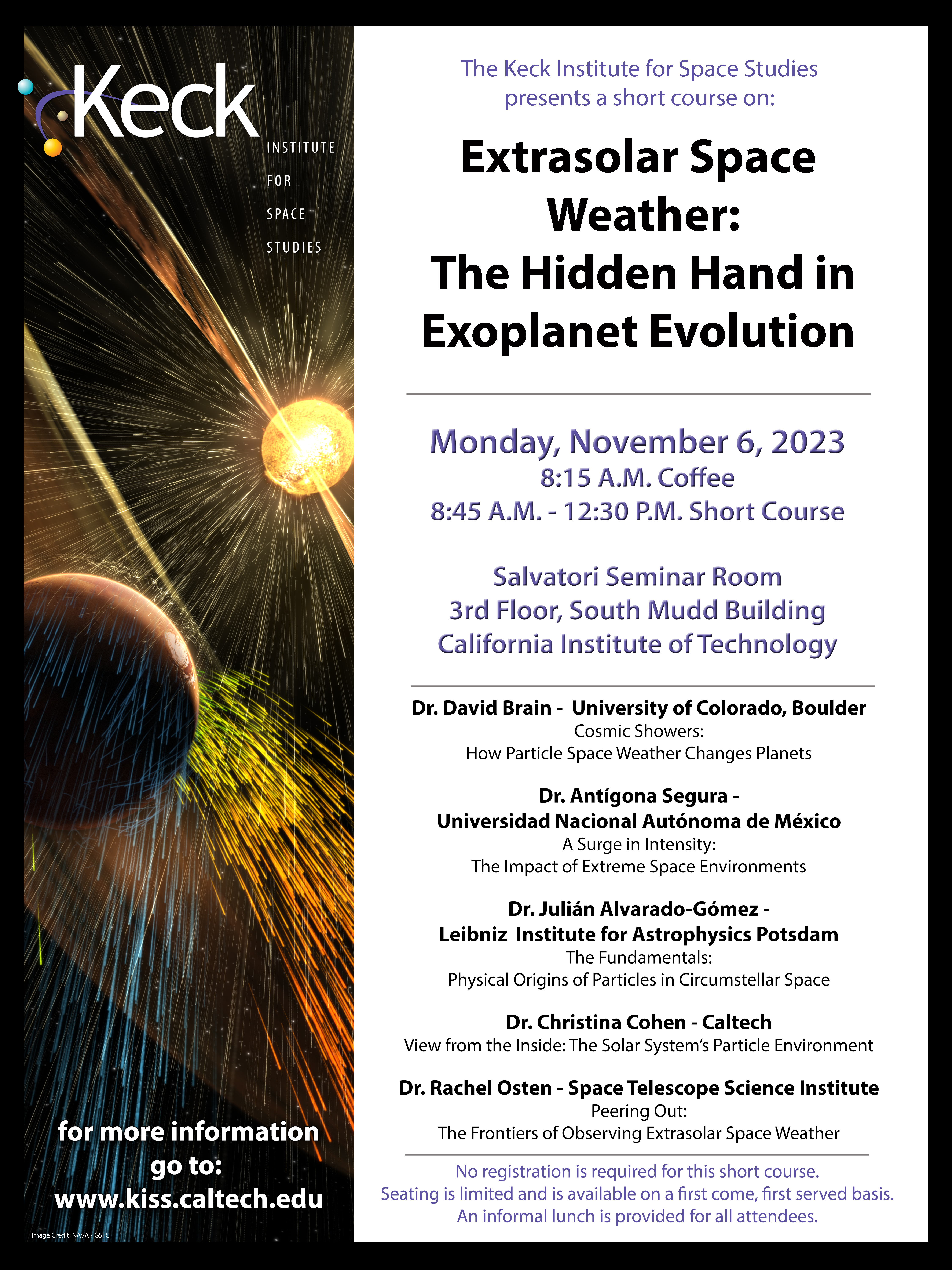Short Course:
Extrasolar Space Weather: The Hidden Hand in Exoplanet Evolution
Monday, November 6, 2023
8:15 A.M. Coffee
8:45 A.M. - 12:30 P.M. Short Course (Informal lunch will be provided for all attendees)
Salvatori Seminar Room, 365 South Mudd Building - California Institute of Technology
Map
All interested researchers and students are invited to attend. No registration is required for the short course. Seating is limited and is available on a first come, first served basis.
Short Course Presentations |
|
| David Brain University of Colorado, Boulder |
Cosmic Showers: How Particle Space Weather Changes Planets (.pdf) |
| Antígona Segura Universidad Nacional Autónoma de México |
A Surge in Intensity: The Impact of Extreme Space Environments (.pdf) |
| Julián Alvarado-Gómez Leibniz Institute for Astrophysics Potsdam |
The Fundamentals: Physical Origins of Particles in Circumstellar Space (.pdf) |
| Christina Cohen Caltech |
View from the Inside: The Solar System's Particle Environment |
| Rachel Osten Space Telescope Science Institute |
Peering Out: The Frontiers of Observing Extrasolar Space Weather (.pdf) |
Program:
Lecture 1 – "Cosmic Showers: How Particle Space Weather Changes Planets" – David Brain
Planetary atmospheres are eroded by space weather through a variety of mechanisms. Learn what some of these mechanisms are, and how their eroding influence changes as stars and planets age together. Find out what effects particles that penetrate deeper into planetary atmospheres can have, including their possible role in the genesis of life.
Lecture 2 – "A Surge in Intensity: The Impact of Extreme Space Environments" – Antígona Segura
Some stars are capable of producing extremely strong flares and likely associated space weather events. Learn how taking space weather to the extremes could change the chemistry of planetary atmospheres. Find out what the implications of extreme space weather might be for life on these planets.
Lecture 3 – "The Fundamentals: Physical Origins of Particles in Circumstellar Space" – Julián Alvarado-Gómez
The dynamic magnetic fields of stars generate a wide variety of electromagnetic and particle space weather alluded to in the earlier talks. Learn what these types of space weather are and how they are generated. Find out how the different magnetic topologies of the Sun and a star much smaller than the Sun influence the space weather they generate.
Lecture 4 – "View from the Inside: The Solar System's Particle Environment" – Christina Cohen
In the Solar System, we benefit from a first-hand view of our own remarkably complex and variable space environment. Learn some of the tools we use to monitor the Sun’s space weather, what they reveal, and how young this observational field still is. Find out about areas that remain hidden from our current in-situ observations, and how connecting solar and stellar observations can help.
Lecture 5 – "Peering Out: The Frontiers of Observing Extrasolar Space Weather" – Rachel Osten
The Sun is just one of billions of stars in our Galaxy that span a huge breadth in size, age, and other characteristics. Learn why our observations lead us to believe many of the same physical processes responsible for the Sun’s space weather are also happening on a diversity of stars. Find out about some ways in which we have attempted to constrain the space weather of stars, and how discrepancies between some of these are driving a need for more and better observations.
